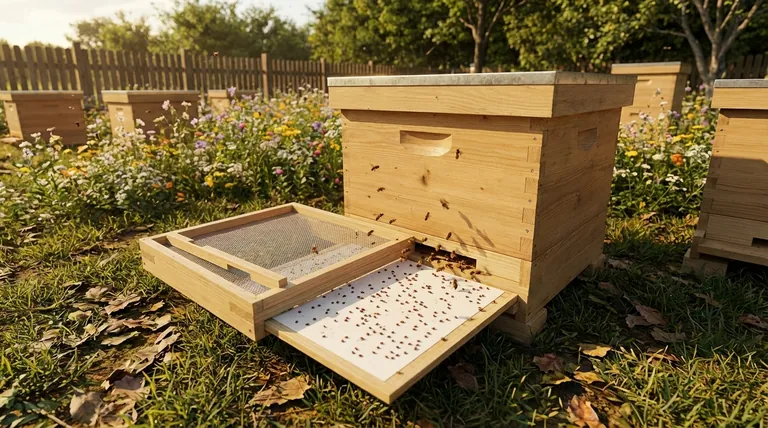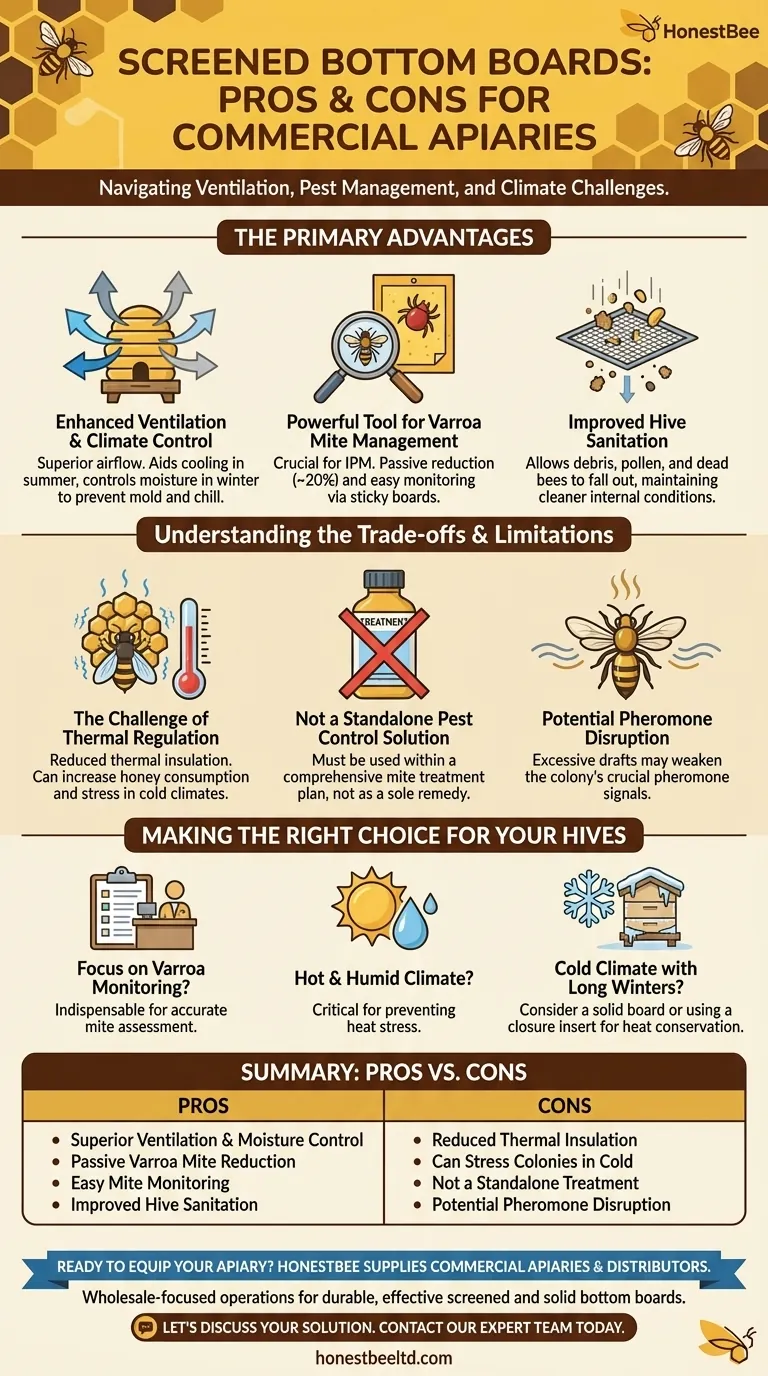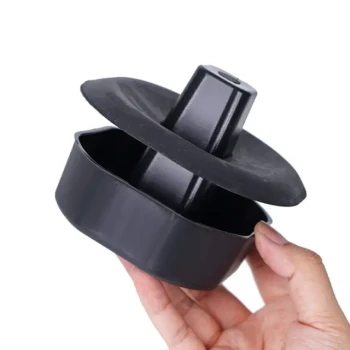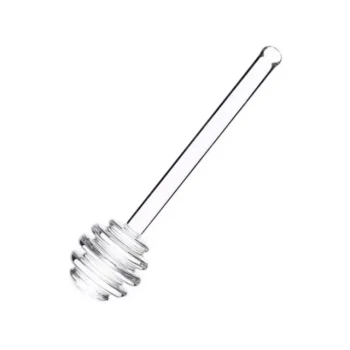In beekeeping, a screened bottom board offers two primary benefits: superior hive ventilation and a crucial advantage in managing Varroa mites. These benefits, however, are balanced by a significant drawback: reduced thermal insulation, which can create challenges for a colony, especially in cooler climates. Your decision ultimately depends on balancing your pest management strategy against the specific environmental conditions of your apiary.
The choice between a screened or solid bottom board is not about which is universally superior, but about selecting the right tool for your climate and beekeeping goals. A screened board is a powerful asset for ventilation and mite monitoring, while a solid board excels at heat conservation.

The Primary Advantages of a Screened Bottom Board
A screened bottom board, sometimes called an "open mesh floor," replaces the hive's traditional solid wood floor with a section of sturdy wire screen. This design fundamentally changes the hive's internal environment.
Enhanced Ventilation and Climate Control
The most immediate impact is a dramatic increase in airflow.
In hot and humid climates, this ventilation is critical for helping the bees cool the hive, reducing the energy they must expend fanning at the entrance.
During winter, proper ventilation helps control moisture. The open screen allows condensation to escape, preventing damp conditions that can chill the cluster and promote disease.
A Powerful Tool for Varroa Mite Management
The screened bottom board was popularized as part of an Integrated Pest Management (IPM) strategy against the destructive Varroa mite.
When mites groom themselves or are groomed off a bee, they can fall from the cluster. With a screened board, a percentage of these mites will fall completely out of the hive, unable to climb back up and re-infest another bee. This passive reduction can lower mite populations by around 20%.
More importantly, the screen allows for easy and accurate monitoring. By placing a "sticky board" (a white, sticky insert) under the screen for a set period, you can count the fallen mites and accurately assess the hive's infestation level without disturbing the colony.
Improved Hive Sanitation
The screen also allows debris such as wax cappings, pollen, and dead bees to fall out of the hive. This helps maintain a cleaner internal environment for the colony.
Understanding the Trade-offs and Limitations
The benefits of a screened bottom board do not come without significant considerations, particularly regarding the colony's ability to regulate its own temperature.
The Challenge of Thermal Regulation
The same ventilation that cools a hive in summer can be a liability in the winter and early spring. A screened bottom board offers virtually no insulation from below.
In cold climates, the colony must consume more honey and work harder to generate the heat needed to keep the cluster warm, potentially increasing winter stress.
This can also affect the colony's spring buildup. Bees may be slower to begin rearing brood if they cannot easily maintain the stable, warm temperatures required in the nursery area.
A Common Misconception in Pest Control
It is critical to understand that a screened bottom board is a management tool, not a standalone treatment for Varroa mites.
While it helps passively reduce mite numbers and is essential for monitoring, it will not solve a serious infestation on its own. It must be used in conjunction with a comprehensive mite treatment plan.
Potential Pheromone Disruption
Some beekeepers express concern that the increased airflow can disrupt the circulation of queen pheromones within the hive. These chemical signals are vital for colony cohesion and communication, and excessive drafts could potentially weaken their effect.
Making the Right Choice for Your Hives
Many modern screened bottom boards come with a removable insert or "closure board" made of wood or corrugated plastic. This offers the best of both worlds, allowing you to run it open in the summer and closed during the cold months.
- If your primary focus is managing Varroa mites: A screened bottom board is an indispensable tool for monitoring mite levels via sticky board counts.
- If you keep bees in a hot and humid climate: The enhanced ventilation from a screened board is critical for preventing heat stress and managing moisture.
- If you operate in a cold climate with long winters: A solid bottom board, or a screened board used with its closure insert, is essential for helping the colony conserve heat.
Ultimately, adapting your equipment to the unique needs of your bees and your specific environment is the hallmark of a successful beekeeper.
Summary Table:
| Pros of a Screened Bottom Board | Cons of a Screened Bottom Board |
|---|---|
| Superior hive ventilation & moisture control | Reduced thermal insulation in winter |
| Passive Varroa mite reduction (~20%) | Can stress colonies in cold climates |
| Enables easy mite monitoring with sticky boards | Not a standalone mite treatment solution |
| Improved hive sanitation from debris falling out | Potential for disruption of hive pheromones |
Ready to equip your apiary with the right tools for success?
At HONESTBEE, we supply commercial apiaries and beekeeping equipment distributors with high-quality screened bottom boards and solid alternatives. Our wholesale-focused operations ensure you get the durable, effective equipment you need to manage hive health, monitor Varroa mites, and adapt to your specific climate.
Let's discuss the best solution for your operation. Contact our expert team today to get started!
Visual Guide

Related Products
- Langstroth Screen Bottom Board for Beekeeping Wholesale
- Australian Pine Wood Langstroth Screen Bottom Board for Wholesale
- Langstroth Solid Bottom Board for Beekeeping
- Professional Ant-Proof Beehive Stand with Integrated Moat for Beekeeping
- Professional Insulated Winter Hive Wrap for Beekeeping
People Also Ask
- What are some considerations when choosing between solid and screened bottom boards? Optimize Hive Health & Pest Control
- What are the benefits of using a screened bottom board in warm or humid climates? Boost Hive Health & Control Pests
- What is the primary function of a screened bottom board in a hive? Enhance Ventilation & Control Varroa Mites
- What are the benefits of a screened bottom board? Boost Hive Health & Control Varroa Mites
- What are the benefits of using a screened bottom board for beehives? Improve Ventilation & Mite Control



















